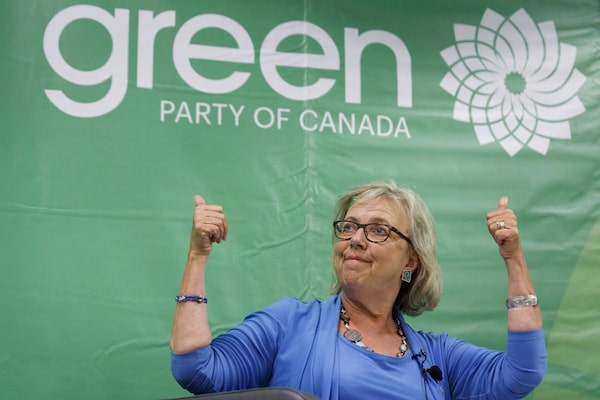
After a brief hiatus, former Green Party leader Elizabeth May is back, and promising a better future for the party than ever.The Canadian Press
Last October, following a disappointing federal election result and the resignation of Green Party leader Annamie Paul, Elizabeth May ruled out a future bid for the top job.
“We have a lot of very talented people in the Green Party,” she told CBC News at the time. “If people turn to me, it’ll look like, ‘Oh, they had nobody but that poor old lady. And there she goes again.’ So I think I want to focus where my energies feel most beneficial.”
Well, perhaps there weren’t so many talented people after all. Or maybe Ms. May feels more spritely than her past comments would suggest. Perhaps she mulled it over and decided that her energies are best tapped when it’s her face plastered across all the party materials. But whatever the reason, after a brief hiatus, Elizabeth May is back, and promising a better Green Party future than ever.
As with most things that go through the recycling process, Ms. May’s leadership bid this time around comes in a slightly different form: she is running as an individual candidate, but on a kind of “joint ticket.” If she wins, she has promised to appoint fellow candidate Jonathan Pedneault as her deputy leader, and vice versa. If successful, their plan is to change the party constitution to allow them to be co-leaders, which Ms. May sees as a way for the pair to have a bigger effect on the political landscape.
In short, what she’s proposing is the old Green Party but with a twist, sort of like when Apple promoted its coveted iPhone 5C in 2013 as “the most colorful iPhone yet,” or like that episode of The Simpsons when the Malibu Stacy doll was reimagined, owing to a single unique accessory. It’s the Elizabeth May Party, circa 2006 to 2019 – but with a new hat.
Much of the party faithful appear delighted at the news of Ms. May’s return, which brings with it a familiar sense of order after a couple of tumultuous years. The Green Party under Ms. Paul appeared fragmented and chaotic, torn apart by a controversy over Israel of all things, which led to the defection of one of the party’s MPs. The party became rife with allegations of internal sabotage and backstabbing. And through it all – and especially as it became clear that Ms. Paul’s leadership was not long for this world – Ms. May remained conspicuously coy about whether she backed her successor, leaving the impression that the Green Party was still hers, with the former leader implicitly giving directions to the rest of the team from the backroom. Ms. Paul’s staffers have suggested Ms. May did not give her successor enough room or support to succeed, but Ms. May says she was only doing as she was told.
Inside the Green bubble, it may seem as though Ms. May’s work is unfinished. After all, she broadened the party’s appeal across Canada, growing the party from a fringe presence in Parliament to a party with three elected MPs in 2019 (which is arguably still a fringe presence, but considerably less so). She was the only female leader of a federal party for more than a decade and pushed important policy not just on climate, but on government transparency and public health. For 13 years, the Green Party really was the Elizabeth May party – which is why the prospect of someone else leading the Greens might seem, from the inside, like an imposter leading a foreign flock.
But from the outside – a fairly important view, for a small party looking to grow – Ms. May’s return looks like the antithesis of party renewal. Indeed, it seems like the resuscitation of an old vanity project that hit a wall in 2019, and is poised to keep banging against it for the foreseeable future. Recent data from Abacus found that in a hypothetical scenario where Pierre Poilievre leads the Conservatives, Jean Charest started his own party and Ms. May was again leading the Greens, Ms. May would garner just 2 per cent of the vote share – less than half that of Maxime Bernier’s People’s Party and comparable to the last federal election result (2.3 per cent).
The big challenge facing the Green Party of 2022 is that its niche is no longer its own. Climate change is a significant and growing component of each other major party’s platform already, meaning that the Green Party has to offer something truly unique to draw support away from them. Perhaps Ms. May and her prospective co-leader, Mr. Pedneault, have those big, bold and new ideas at the ready, but so much of politics is perception, and the perception of a party returning to its former and once-defining leader is that it’s stuck and out of ideas. A party cannot grow if it’s seen as moving backward.
So Ms. May’s leadership is like the paper straw of Canadian politics: it might be great at the beginning, but it’s not suitable for multiple uses. And if you leave it in your drink for too long, the whole thing turns to mush.
Keep your Opinions sharp and informed. Get the Opinion newsletter. Sign up today.